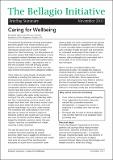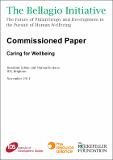| dc.description.abstract | ‘Care’, and the associated idea of ‘social reproduction’,2 are concepts originally developed by feminist scholars and activists to describe a responsibility and a set of activities defined for the present paper as meeting the material and/or developmental, emotional and spiritual needs of one or more other persons with whom one is in a direct personal relationship.3 Until challenged by feminists, care was seen as something that women ‘naturally’ did and thus not identified as an issue requiring a policy response. This is often still the case today. For example, the framing of ‘food security’ excludes unpaid care, ignoring the fact that even when sufficient food is available and accessible, individuals can only eat if someone collects water and fuel and spends the time and skills to transform the raw ingredients into a palatable meal.
Care is not just a private matter for individuals. It needs to be thought of at the macro/structural level about how the wellbeing of some may be at the cost of wellbeing or others, often the powerless and vulnerable. It requires examining deeply embedded societal assumptions to recognise that the division of responsibility in caring is informed by ideologies of what it means to be male and female (Edholm, Harris and Young. 1978).4 Many cross-country comparative studies (Budlender 2010) have shown how prevailing gender norms mean that women undertake the bulk of unpaid care work including minding and educating children, looking after older family members, caring for the sick, cooking and collecting water and fuel. Although there has been a shift towards
a more equal distribution of responsibilities between the sexes in the past 40 years – particularly in Scandinavia – in most countries the provision of care continues to lie chiefly with women and girls. At the same time increasing numbers of women are taking up paid work. Because they have to juggle their responsibilities, women are frequently employed on a part-time or piecework basis where wages are lower, employment less secure and collective action or negotiation more difficult (Chen 2007). With many women thus employed, the young and the elderly have to take on more care responsibilities to the detriment of their own wellbeing. In some countries these changes have coincided with a decline of state provision and everywhere an increased involvement of the
market in care. Women who can afford to do so hire poorer women, often underpaid and
overworked (Razavi and Staab 2010) and in many parts of the world subject to racial
discrimination.
In this context of global change our paper considers the centrality of care for human wellbeing and the damage caused by its sustained neglect in policy and practice. Section 2 looks at care 2 within the prevailing development paradigm. Section 3 makes a case for care based on a relational approach to wellbeing. Section 4 proposes that philanthropic organisations play a leading role in making care visible and in facilitating the debate about the changes required for building more people-centred economies. | en_GB |


